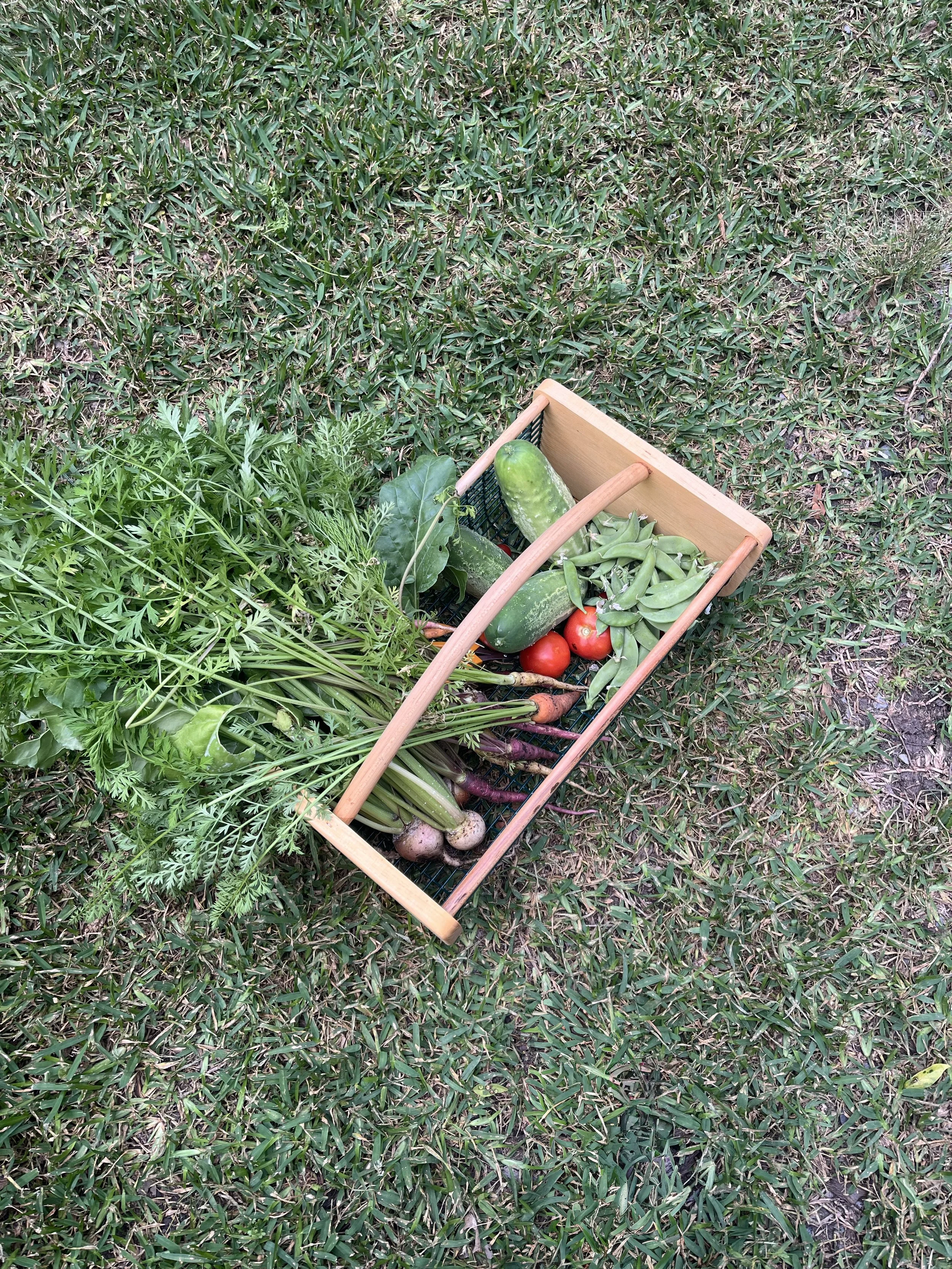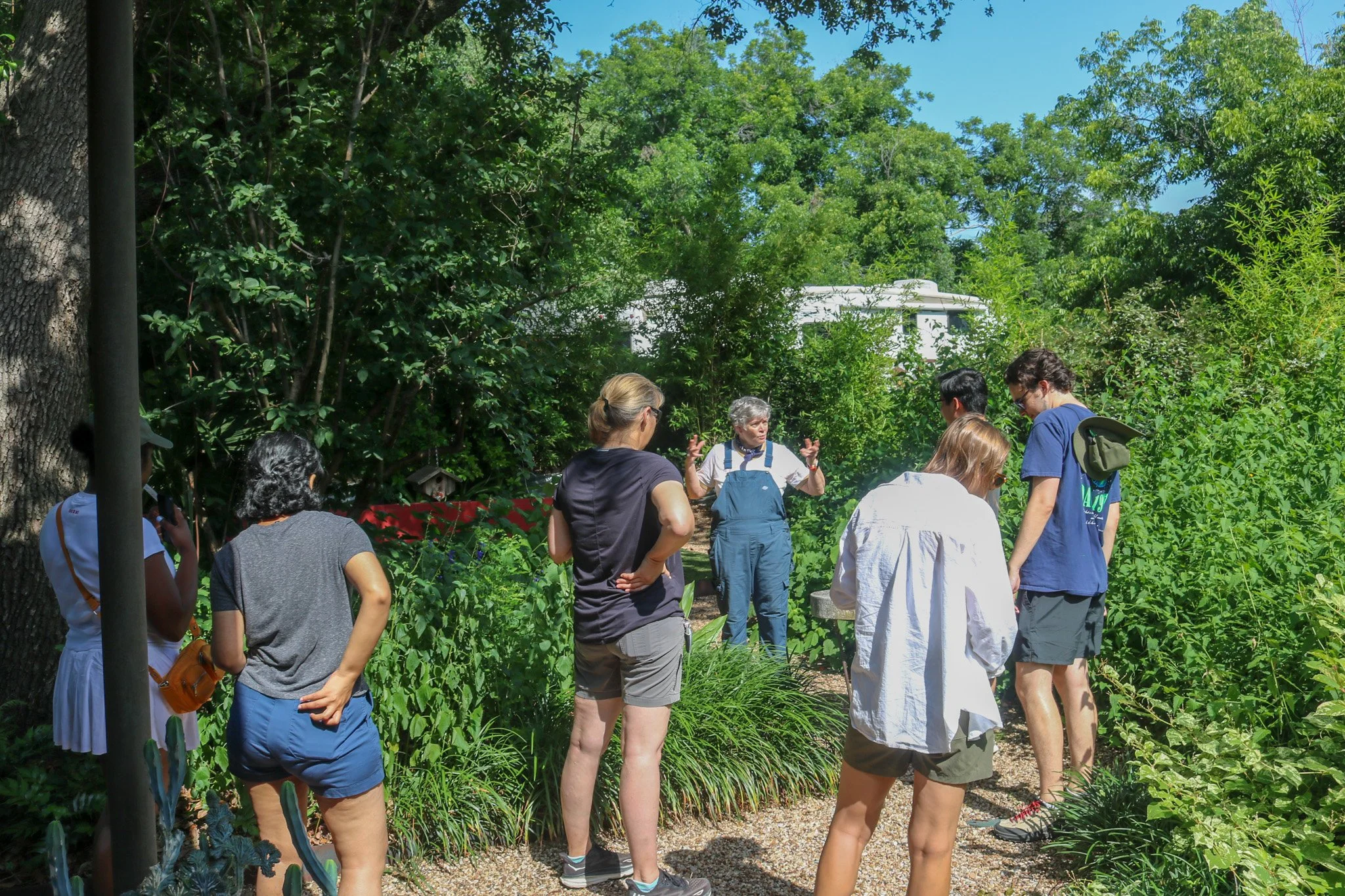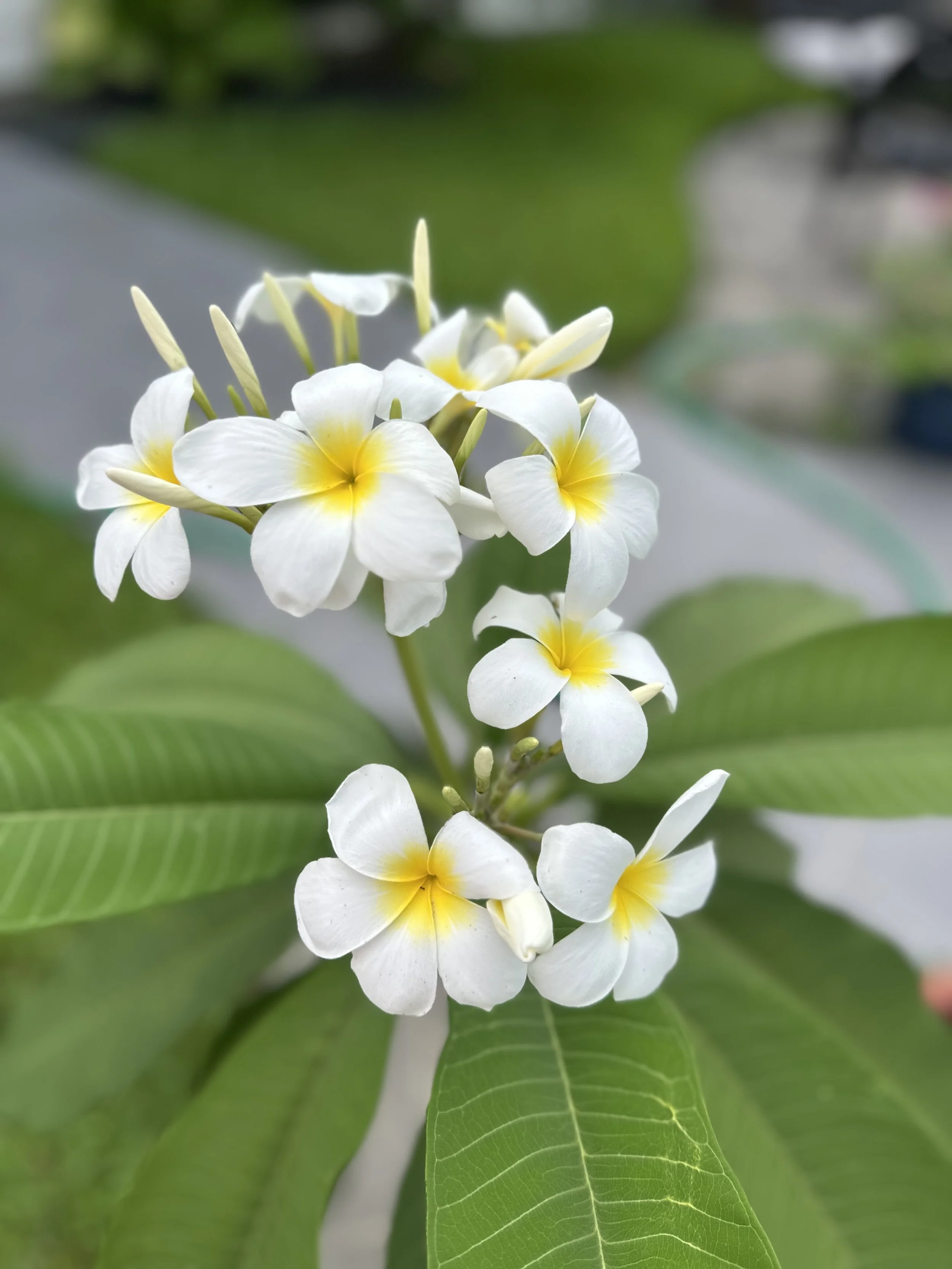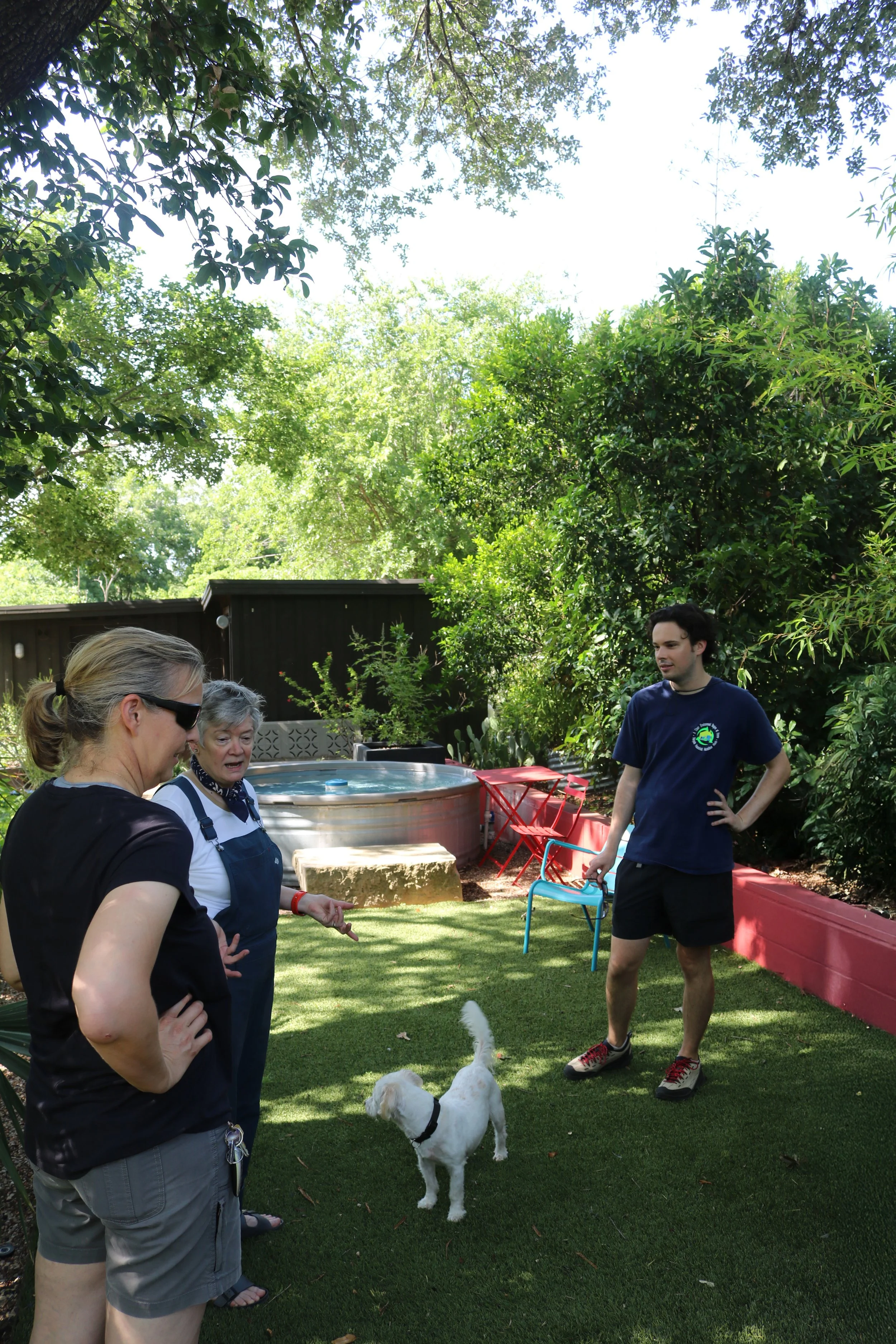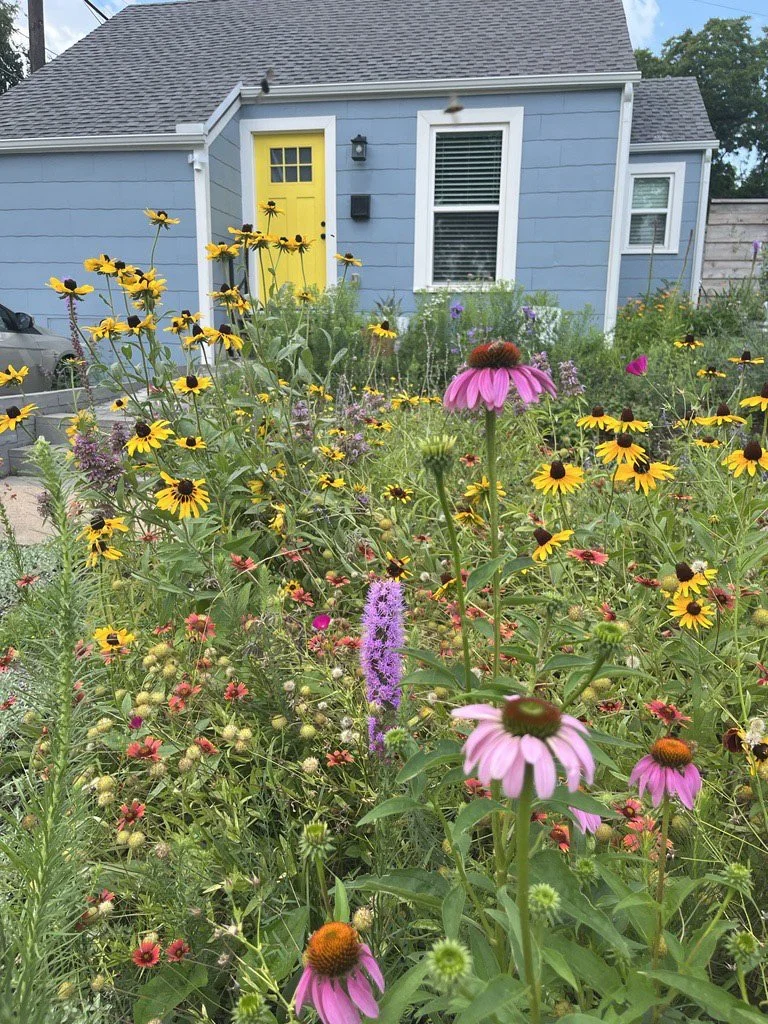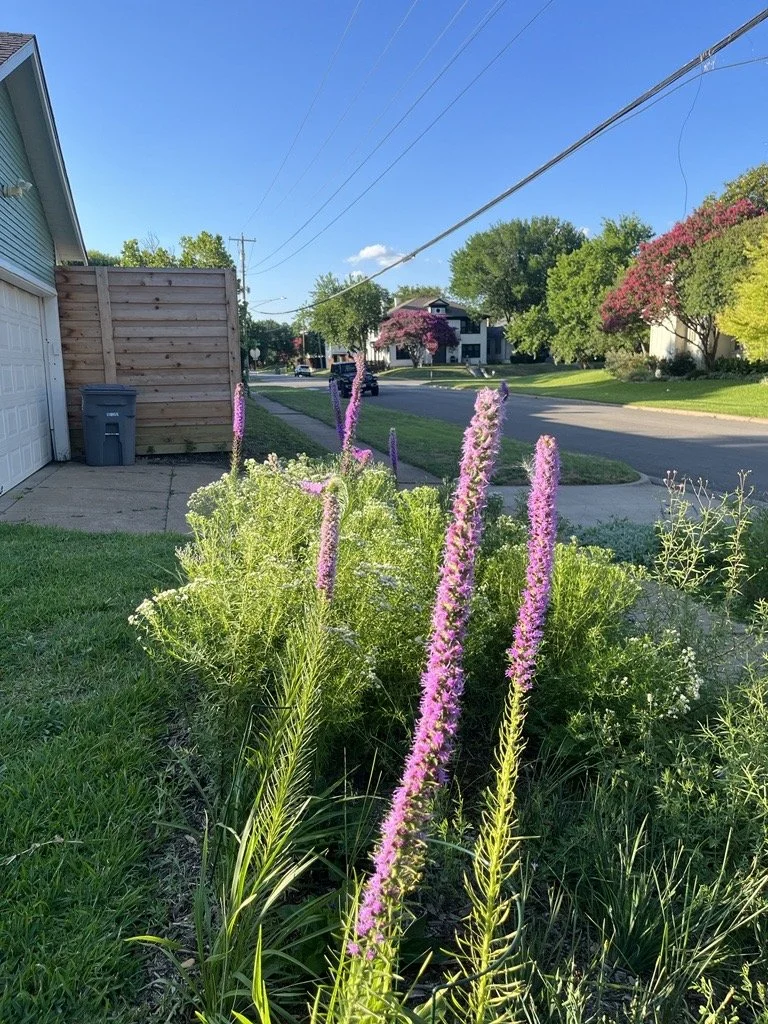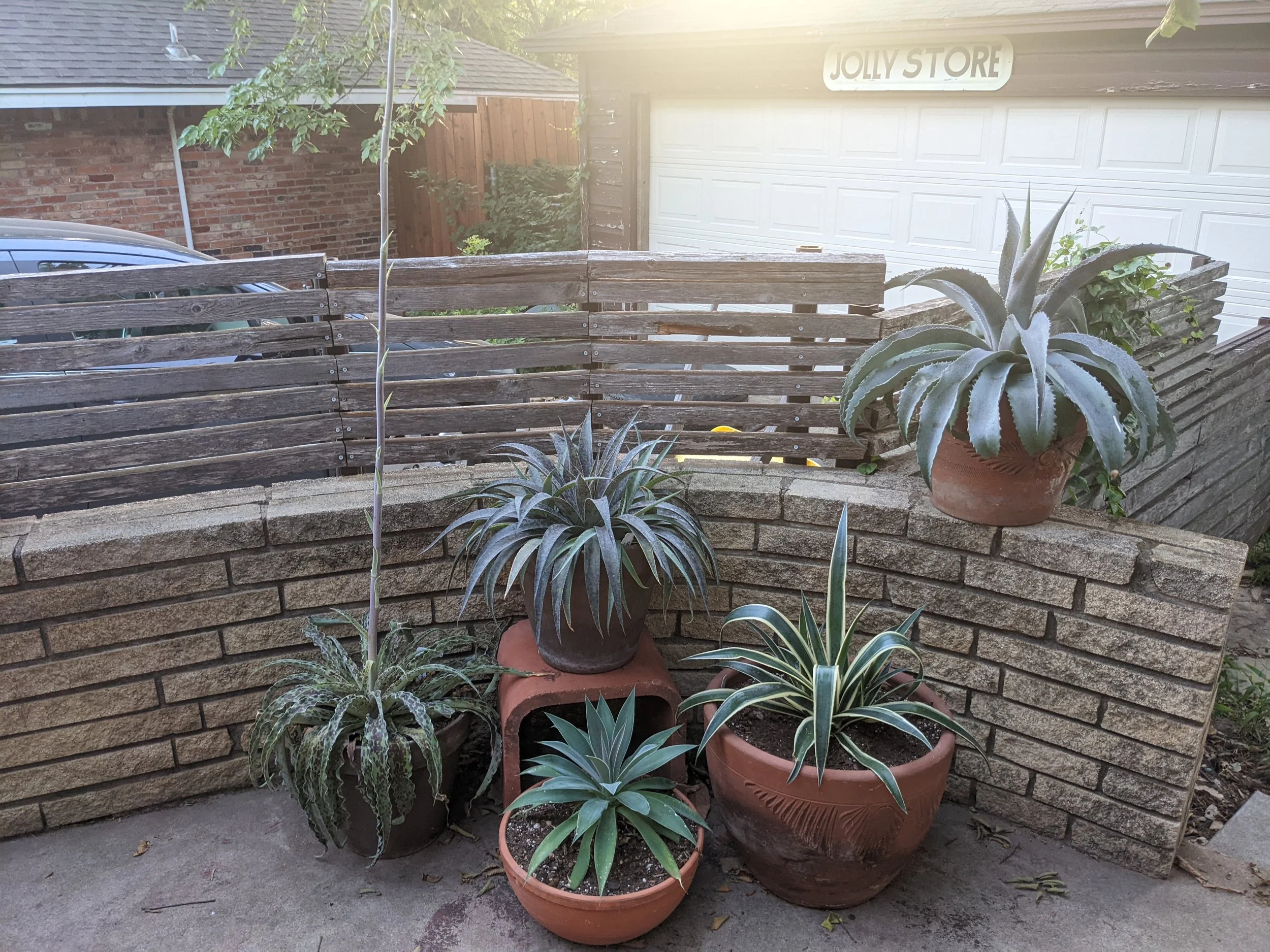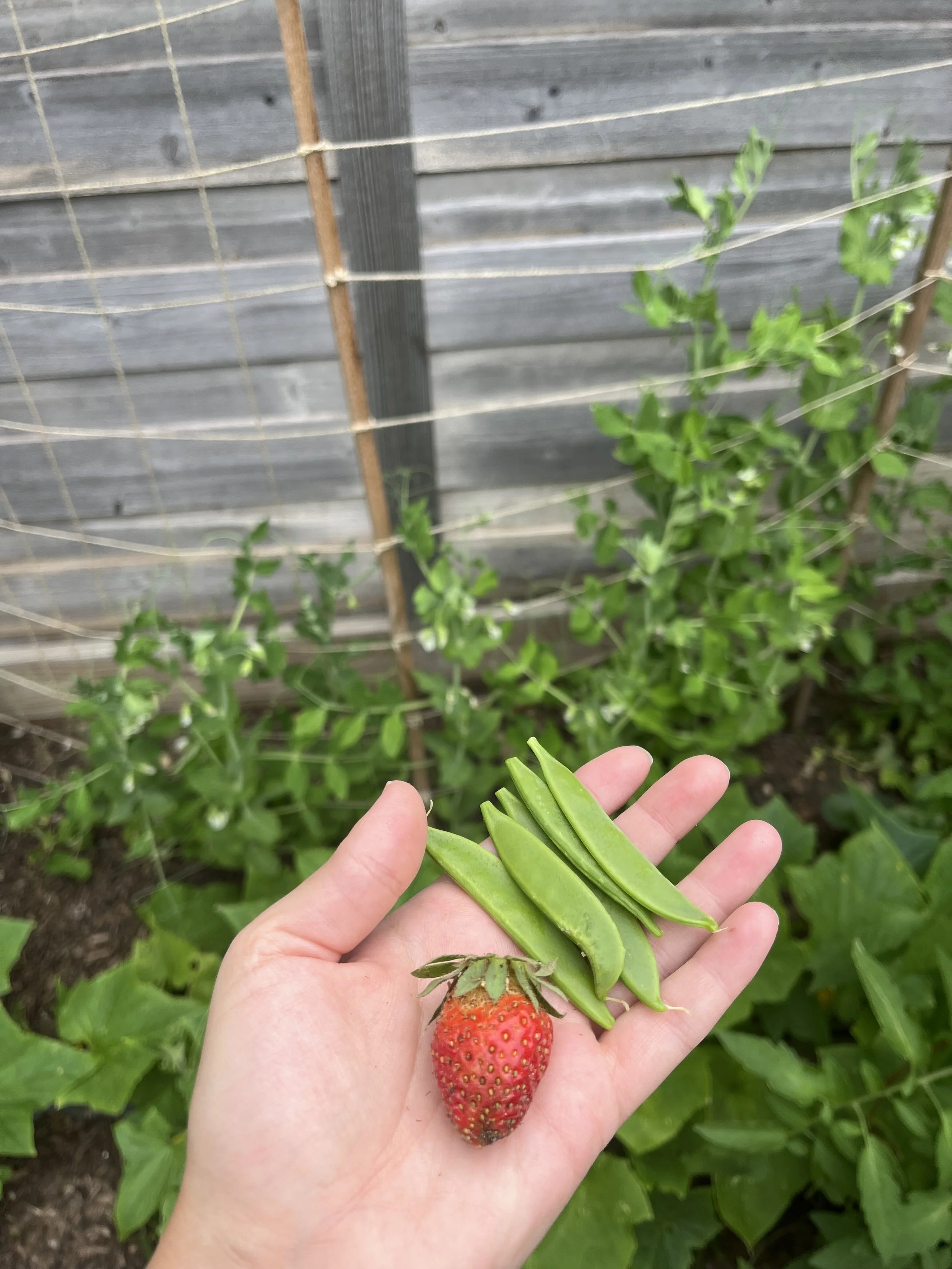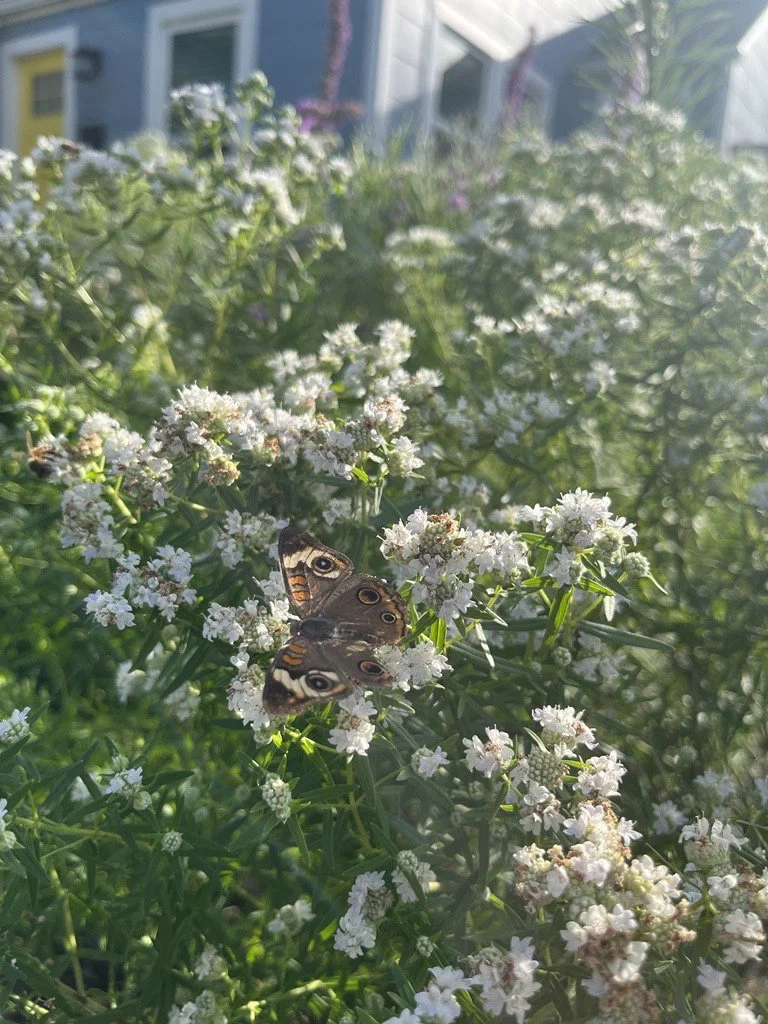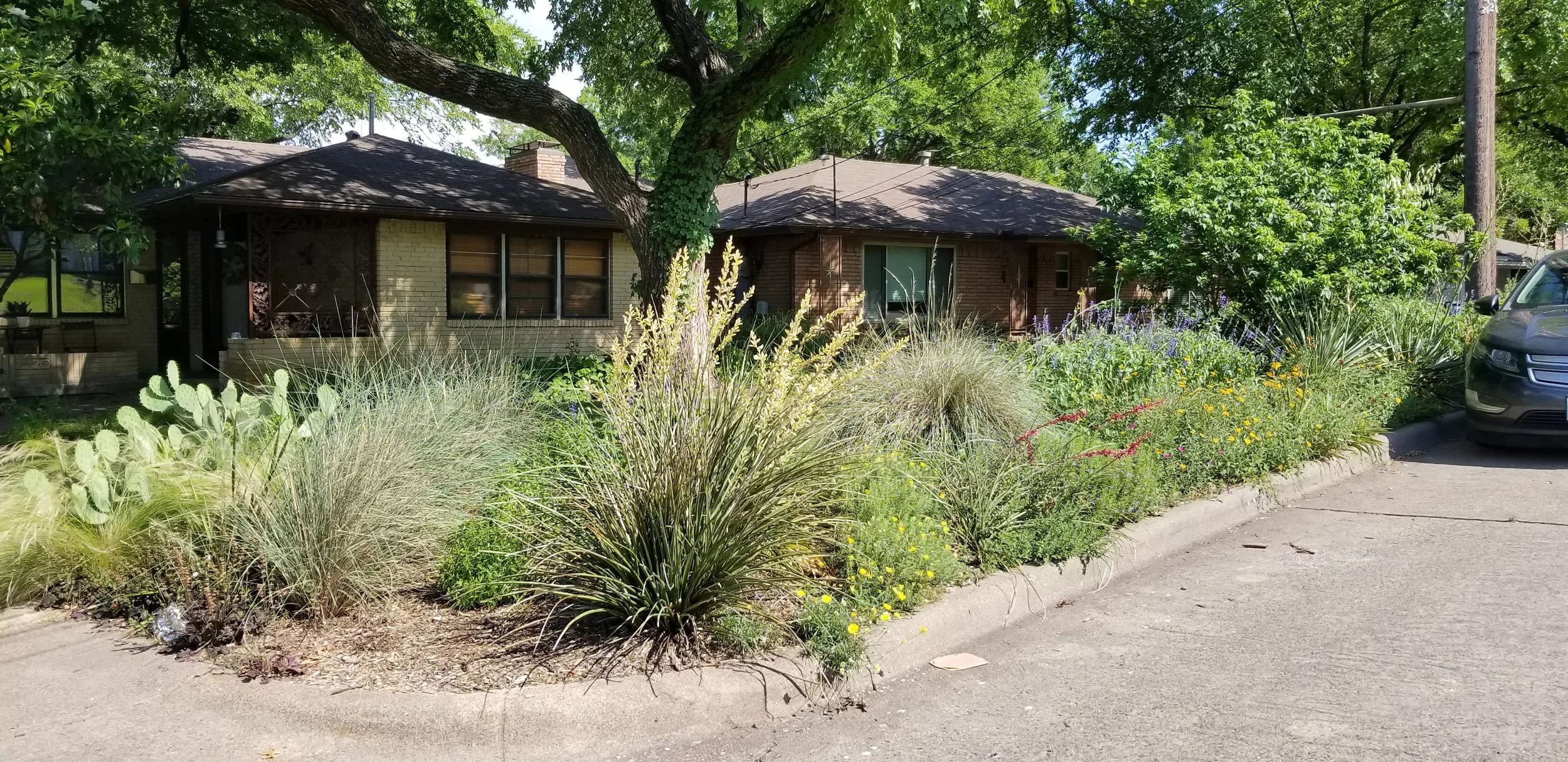At Studio Outside, design is more than a profession—it is a way of seeing the world. For many of us, that perspective carries far beyond the workplace, finding new life in the places we call home. Our designers do not just talk about plants and spaces during the day—they go home and live in the landscapes they have crafted themselves. Whether it is a wild habitat in a front yard, a patio overflowing with herbs, or a carefully curated blend of native perennials and tropical favorites, these gardens offer a glimpse into the passions, priorities, and personalities of the people who shape the firm.
For each Outsider, the story of gardening begins a little differently. Some grew up surrounded by plants, nurtured by parents or grandparents who instilled a love for tending the land. Others found their way to gardening through unexpected life events or a desire to reconnect with nature outside of work.
Vegetables from Meghan’s garden.
For Project Leader Declan Devine, the spark was planted early.
“I grew up and did a butterfly garden with my mom and we raised butterflies together,” he says. “So that was my start in gardening and kind of the spark.”
His partner, fellow Project Leader Meghan Obernberger, came to gardening later, during the stillness of the pandemic.
“I had a food garden at home, and then ever since then, I've just always had one,” she shares.
Senior Associate Lorie Kinler took a more long-term approach. When she and her husband, also a landscape architect, bought their home two decades ago, it was a blank canvas. Over time, their yard became an evolving experiment in design and plant performance.
“We also own the house next door, and that used to be our design office, and so the two yards were like a plant laboratory for us,” she explains. “We would try different plants just to see how they did in our heat, in our winter.” Lorie explained how the harsh winter a few years back cost them quite a bit of plants, “We learned that, okay, this is not going to work now that it is getting colder here. We are going to have to adjust our palette.”
Lorie giving outsiders a tour of her home garden.
Principal Brian Halsell’s gardening roots reach back to high school, though his perspective deepened through his training as a Texas Master Naturalist.
“I love plants. I love the outdoors. Even when I was in junior high and high school, I would just mess around with stuff in our yard at home,” he says. “I've always been into artistic endeavors outside.”
A plumeria from Alex Nicol’s family garden.
That hands-on experience gave him a deeper appreciation for ecological systems and inspired the largely native landscape he stewards today. For Intern Alex Nicol, gardening is deeply tied to cultural identity. Growing up he was surrounded by tropical plants, and he now brings that influence into his Texas garden.
“I'm from the islands, so that influences it to the kind of plants that I pick,” he explains. “Fortunately, enough, we have a bunch of tropical plants, and I guess Texas isn't too bad for that, but I keep my culture and identity in mind whenever I do that.”
These gardens are, unsurprisingly, shaped by design thinking. Lorie describes their layout as a series of intentional outdoor rooms:
Lorie’s lawn and stock tank pool.
“We thought about the whole composition. It is not just about plants—it is about the spaces,” she says. “We have three distinct spaces: our patio space is right off of our house, and then beyond that is a large planting area, and then on the other side is the lawn area with the stock tank pool.”
For Meghan and Declan, the design is more fluid. “Originally, the agreement was I get the backyard, and he gets the front yard, but we blurred the lines,” Meghan laughs.
“We have okra growing in the front yard as well, that’s where we really overlap,” Declan adds. “It’s mixed with cosmos which bloom like crazy.”
“And that's like more of an ornamental versus like, for food or ecological benefit,” Meghan interjects.
“It's kind of a full combo of vegetable gardening and pollinator gardening,” Declan concludes.
Gallery above features Meghan and Declan’s combined gardens.
Even with a modest patio, Project Leader Alex Dial brings care and intention to her space. “It’s definitely a mix of relaxation and utility,” she says. “Just sitting on a patio, clipping and trimming them, smelling everything, it’s the full experience that I enjoy.”
Images from Alex Dial’s balcony garden.
Brian takes a tougher stance with his native-heavy yard: “I don't have irrigation, and I don't water things after the first two weeks, unless it's the middle of summer, but I rarely plant in the middle of summer,” he explains. “Basically, I'll plant it, I'll water it once or twice, and then it's got to live on its own; If not, then it's not a good plant.” Brian feels that his garden is a test garden and a wild habitat.
Time spent in the garden varies from person to person, shaped by schedules, seasons, and the unique rhythms of each household. But no matter the amount of time, every gardener agrees: it is time well spent. Whether it is for maintenance, observation, or simply unwind, these moments are often where connection, reflection, and quiet joy take root.
Some of Meghan’s vegetable garden harvest.
“Several hours on the weekends, for sure,” says Lorie. “My husband and I are both out there—curating, weeding, cutting back whatever needs to be done. And then relax. We sit out there a lot in the evenings and enjoy the garden.”
Declan estimates, “Probably about an hour a day,” while Meghan adds, “And weekends, we'll probably spend like four to six hours.” They note that there is always something to tend to as their time in the garden is a mix of routine and wandering.
Alex Nicol’s time outside ramps up in warmer months: “I’m always out there in the summertime,” he says. “My dad has me working on the garden, whenever I'm back home from school.”
Brian focuses more on his potted plants: “In the spring, I’ll spend maybe three to four hours each weekend.” He has two rain tanks that hold 250 gallons of water that are used to water the potted plants. “Right now, I'm not spending hardly any time, except for mowing, which is less than an hour, because I don't have much lawn.”
Brian’s potted plants.
Every gardener has their frustrations. When trying something new there is always a risk of failure. Although it can be discouraging at times, trial and error is the best way to attempt something new.
“A surprising failure was when we had that snowmageddon and we lost plants that normally would have made it through our winters,” says Lorie. “We really had to look at it and start thinking ‘okay, we are not going to use that plant again’ because if it gets down to zero, it is not going to make it,” she adds. “I think the thing it’s taught me, is just understanding how much maintenance a garden requires.” Lorie explains how she has had clients ask for a yard that is no maintenance and how she had to clarify that nothing is no maintenance. “There’s always going to be some kind of maintenance and just learning the maintenance of my own garden helped me temper my expectations,” she says.
For Alex Dial, one towering tomato plant just would not cooperate: “It just keeps growing big—it flowers and then it doesn't produce any fruit and it just gotten so tall.”
Brian shares a similar struggle: “I continually try to grow cucumbers. I had one good year, long time ago, because I love cucumbers, but I cannot grow them for some reason.”
Homegrown foods from Meghan’s food garden.
Other lessons were more philosophical. “Plants are just going to go where they go,” says Declan.
“You’re never fully in control.” Meghan agrees, noting their own battles with pests. “We tried sunflowers, and they would sprout, and get relatively tall, and then something would, like…”
“Decimate them,” Declan adds. “They'd form a bloom bud, and then something came and would eat the bloom bud off and mangle it.”
Meghan has also given up on brassicas: “They always get annihilated by caterpillars and cabbage whites. And it is always a battle if you do not want to use detrimental means.”
But even among the failures, the small wins are deeply satisfying. “We had a good success with our cucumber plant this summer,” Meghan says. “We’ll be making pickles for the state fair.”
Declan’s buckeye butterfly on mountain mint.
Declan found joy in experimenting with native species: “I tried that some new stuff this year that I've never had before, particularly mountain mint.” Declan explained how we are south of its natural range, which ends in Oklahoma along the Red River. “It has thrived, it has just been an absolute pollinator magnet, which has been really satisfying to see how successful it's been.”
Brian’s been impressed by his tomato harvest: “I've had an incredible year this year with tomatoes, so I might have actually saved money with tomatoes this year.”
Alex Nicol lights up talking about his surprise success: “I have this alocasia polly that I've been taking care of, and it's supposed to be a pretty hard plant to grow, but I've been able to keep it alive and it's growing full.”
There are quirks too—delightful details that might be surprising to know about the gardeners behind them. “I have a stock tank pool,” Lorie shares. “We have matured live oaks in our backyard, so we didn't want to do a pool.” The Kinlers were cautious, not wanting to damage any of the mature trees that they have. Not only is a stock tank pool a great place to cool off in the Texas heat, but it also serves as a water feature, providing the garden with the calming sounds of recirculating water.
Meghan and Declan are experimenting in the public eye: “We kind of have a show bed in the front,” she says. “We have some tomatoes on there, and then we're trying to grow a pumpkin because I think it'll be pretty entertaining.” Meghan is excited to see how the neighborhood reacts to this new addition to the garden.
Brian embraces a more chaotic aesthetic: “I think people outside the office who know I'm a landscape architect would be surprised by how wild it looks,” he says with a laugh. “It's pretty hairy.”
Brian’s “hairy” garden.
Alex Dial admits, “I’ve let a lot of plants die, I’m not a perfect gardener.”
Alex Nicol’s family has tropical plants that are not as well known. “We grow bitter melon,” he laughs. “I do not think anyone knows what that is. It is actually disgusting—but it is good for you.” He describes it as the vegetable version of grapefruit because of its bitter flavor.
Alex Nicol’s family home garden.
Lorie’s luscious front garden.
When asked what they hope visitors notice when visiting their gardens for the first time, their answers have little to do with perfection. “Just how thoughtfully it is laid out,” says Lorie. “It's not just about plants, it's about the spaces and how you can experience the garden, depending on what space you're in.”
Declan echoes that: “We’ve successfully done gardening in a small space very well, and we've also integrated our two domains in an interesting way.” Meghan adds, “There's been so many moments of surprise in everyday life just seeing stuff in our yard.” They explained how their main goal is to get people out there and encourage them to start their own garden. “I want to hopefully inspire people to do similar things,” Declan concludes.
At Studio Outside, we pride ourselves on crafting thoughtful landscapes for public spaces, institutions, and communities. But these home gardens remind us of something equally important: design lives in everyday life. It is in the pots on the balcony, the raised beds in the front yard, the agave growing stubbornly in the shade. It is in our habits, our heritage, and our hopes for what space can be. And just like the gardens themselves, that kind of design never stops growing.


